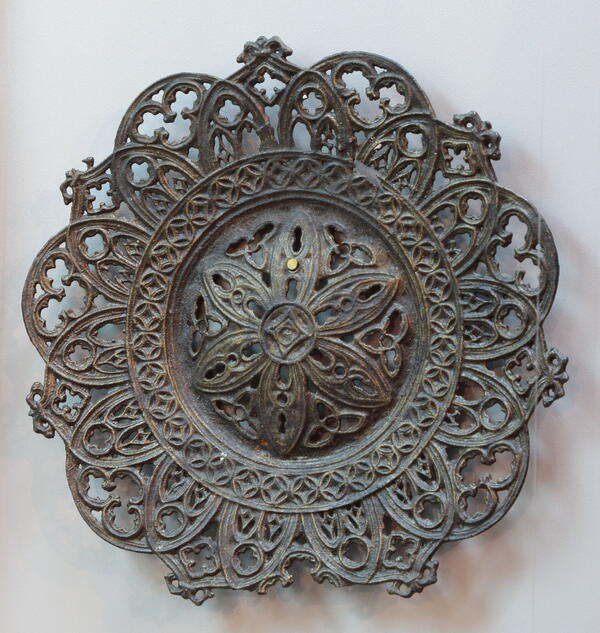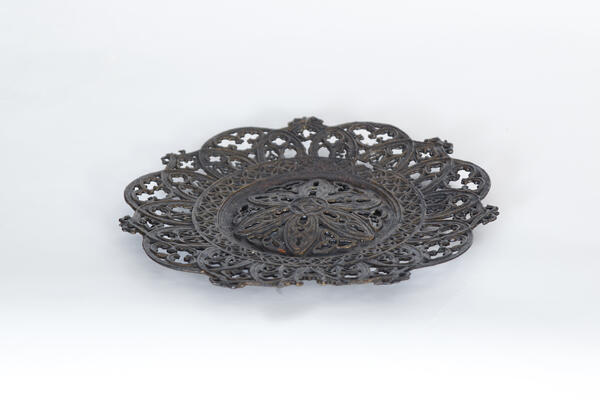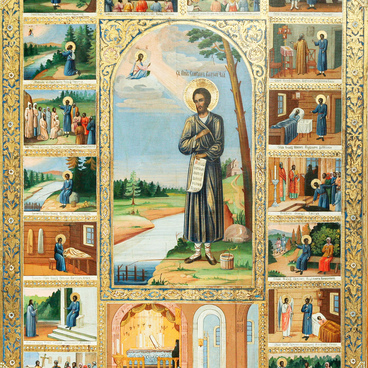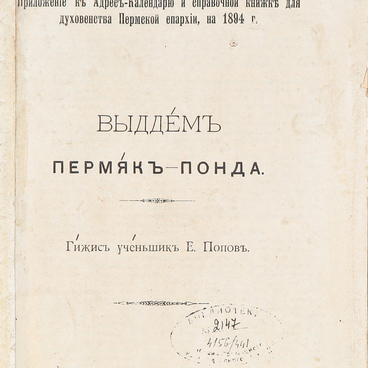This flat openwork dish with a floral ornament is made in the Gothic style. In the center is a sexfoil bordered with a wide stripe. The edges of the dish are made in the form of semi-circular and dome-shaped petals, which alternate along the circumference. The elegant cast-iron plate was used as a wall decorative platter or fruit plate.
The dish is made in the classical style, following the traditions of the 19th century Kaslinsky castings. The Kaslinsky technique is characterized by the graphic precision of the silhouette, the combination of carefully finished details and synthesized surfaces, and also the coating with special carbon black dye. Its recipe has been kept secret for 200 years. The dish is made from cast iron at the Kuvinsky foundry, founded by Counts Stroganov. Cast iron melts at relatively low temperatures, it is malleable, fluid and yielding in processing, so it is widely used in construction, engineering and art.
The dish was donated to the museum in 1937 by the artisan who created it, Fyodor Ivanovich Nekrasov from the village of Kuva, Kudymkar district, Perm region. The craftsmen at the local Kuvinsky foundry mastered the process of iron production and, in the process of producing ingots, gradually developed the technology. At the same time the factories got better equipped, and by the end of the 19th century they turned to producing artistic and household items: decorative ashtrays in the form of maple leaves and folded palms, photo frames, dishes, statuettes, hangers and hand-washing kettles. Ural craftsmen became famous throughout the world, and art schools were opened at the factories where they studied drawing, molding, and embossing.
From 1929 to 1975, 50 artistic castings were added to the collection of the Museum of Local History. All of them were made by artisans of the Pozhevsky, Maikorsky and Kuvinsky foundries and ironworks, which operated in the Perm Governorate in the 18th — early 20th centuries. The artworks of the Kaslinsky foundry were awarded the gold medal Grand Prix at the World Expo in Paris. The openwork dish is the pinnacle of the caster Fyodor Nekrasov’s work, recognized as an item of national heritage.
The dish is made in the classical style, following the traditions of the 19th century Kaslinsky castings. The Kaslinsky technique is characterized by the graphic precision of the silhouette, the combination of carefully finished details and synthesized surfaces, and also the coating with special carbon black dye. Its recipe has been kept secret for 200 years. The dish is made from cast iron at the Kuvinsky foundry, founded by Counts Stroganov. Cast iron melts at relatively low temperatures, it is malleable, fluid and yielding in processing, so it is widely used in construction, engineering and art.
The dish was donated to the museum in 1937 by the artisan who created it, Fyodor Ivanovich Nekrasov from the village of Kuva, Kudymkar district, Perm region. The craftsmen at the local Kuvinsky foundry mastered the process of iron production and, in the process of producing ingots, gradually developed the technology. At the same time the factories got better equipped, and by the end of the 19th century they turned to producing artistic and household items: decorative ashtrays in the form of maple leaves and folded palms, photo frames, dishes, statuettes, hangers and hand-washing kettles. Ural craftsmen became famous throughout the world, and art schools were opened at the factories where they studied drawing, molding, and embossing.
From 1929 to 1975, 50 artistic castings were added to the collection of the Museum of Local History. All of them were made by artisans of the Pozhevsky, Maikorsky and Kuvinsky foundries and ironworks, which operated in the Perm Governorate in the 18th — early 20th centuries. The artworks of the Kaslinsky foundry were awarded the gold medal Grand Prix at the World Expo in Paris. The openwork dish is the pinnacle of the caster Fyodor Nekrasov’s work, recognized as an item of national heritage.




